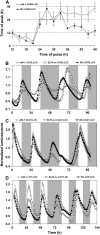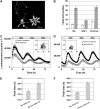ELF4 is required for oscillatory properties of the circadian clock
- PMID: 17384164
- PMCID: PMC1913775
- DOI: 10.1104/pp.107.096206
ELF4 is required for oscillatory properties of the circadian clock
Abstract
Circadian clocks are required to coordinate metabolism and physiology with daily changes in the environment. Such clocks have several distinctive features, including a free-running rhythm of approximately 24 h and the ability to entrain to both light or temperature cycles (zeitgebers). We have previously characterized the EARLY FLOWERING4 (ELF4) locus of Arabidopsis (Arabidopsis thaliana) as being important for robust rhythms. Here, it is shown that ELF4 is necessary for at least two core clock functions: entrainment to an environmental cycle and rhythm sustainability under constant conditions. We show that elf4 demonstrates clock input defects in light responsiveness and in circadian gating. Rhythmicity in elf4 could be driven by an environmental cycle, but an increased sensitivity to light means the circadian system of elf4 plants does not entrain normally. Expression of putative core clock genes and outputs were characterized in various ELF4 backgrounds to establish the molecular network of action. ELF4 was found to be intimately associated with the CIRCADIAN CLOCK-ASSOCIATED1 (CCA1)/LONG ELONGATED HYPOCOTYL (LHY)-TIMING OF CAB EXPRESSION1 (TOC1) feedback loop because, under free run, ELF4 is required to regulate the expression of CCA1 and TOC1 and, further, elf4 is locked in the evening phase of this feedback loop. ELF4, therefore, can be considered a component of the central CCA1/LHY-TOC1 feedback loop in the plant circadian clock.
Figures






Similar articles
-
ELF4 is a phytochrome-regulated component of a negative-feedback loop involving the central oscillator components CCA1 and LHY.Plant J. 2005 Oct;44(2):300-13. doi: 10.1111/j.1365-313X.2005.02531.x. Plant J. 2005. PMID: 16212608
-
A functional link between rhythmic changes in chromatin structure and the Arabidopsis biological clock.Plant Cell. 2007 Jul;19(7):2111-23. doi: 10.1105/tpc.107.050807. Epub 2007 Jul 6. Plant Cell. 2007. PMID: 17616736 Free PMC article.
-
A genetic study of the Arabidopsis circadian clock with reference to the TIMING OF CAB EXPRESSION 1 (TOC1) gene.Plant Cell Physiol. 2009 Feb;50(2):290-303. doi: 10.1093/pcp/pcn198. Epub 2008 Dec 19. Plant Cell Physiol. 2009. PMID: 19098071
-
From a repressilator-based circadian clock mechanism to an external coincidence model responsible for photoperiod and temperature control of plant architecture in Arabodopsis thaliana.Biosci Biotechnol Biochem. 2013;77(1):10-6. doi: 10.1271/bbb.120765. Epub 2013 Jan 7. Biosci Biotechnol Biochem. 2013. PMID: 23291766 Review.
-
MYB transcription factors in the Arabidopsis circadian clock.J Exp Bot. 2002 Jul;53(374):1551-7. doi: 10.1093/jxb/erf027. J Exp Bot. 2002. PMID: 12096093 Review.
Cited by
-
Red Light Resets the Expression Pattern, Phase, and Period of the Circadian Clock in Plants: A Computational Approach.Biology (Basel). 2022 Oct 9;11(10):1479. doi: 10.3390/biology11101479. Biology (Basel). 2022. PMID: 36290383 Free PMC article.
-
A simplified modelling framework facilitates more complex representations of plant circadian clocks.PLoS Comput Biol. 2020 Mar 16;16(3):e1007671. doi: 10.1371/journal.pcbi.1007671. eCollection 2020 Mar. PLoS Comput Biol. 2020. PMID: 32176683 Free PMC article.
-
Light and circadian regulation of clock components aids flexible responses to environmental signals.New Phytol. 2014 Jul;203(2):568-577. doi: 10.1111/nph.12853. Epub 2014 May 20. New Phytol. 2014. PMID: 24842166 Free PMC article.
-
GIGANTEA and EARLY FLOWERING 4 in Arabidopsis exhibit differential phase-specific genetic influences over a diurnal cycle.Mol Plant. 2012 May;5(3):678-87. doi: 10.1093/mp/sss005. Epub 2012 Feb 10. Mol Plant. 2012. PMID: 22328721 Free PMC article.
-
TIME FOR COFFEE encodes a nuclear regulator in the Arabidopsis thaliana circadian clock.Plant Cell. 2007 May;19(5):1522-36. doi: 10.1105/tpc.106.047241. Epub 2007 May 11. Plant Cell. 2007. PMID: 17496120 Free PMC article.
References
-
- Alabadi D, Oyama T, Yanovsky MJ, Harmon FG, Mas P, Kay SA (2001) Reciprocal regulation between TOC1 and LHY/CCA1 within the Arabidopsis circadian clock. Science 293 880–883 - PubMed
-
- Alabadi D, Yanovsky MJ, Mas P, Harmer SL, Kay SA (2002) Critical role for CCA1 and LHY in maintaining circadian rhythmicity in Arabidopsis. Curr Biol 12 757–761 - PubMed
-
- Clough SJ, Bent AF (1998) Floral dip: a simplified method for Agrobacterium-mediated transformation of Arabidopsis thaliana. Plant J 16 735–743 - PubMed
Publication types
MeSH terms
Substances
LinkOut - more resources
Full Text Sources
Molecular Biology Databases
Research Materials

